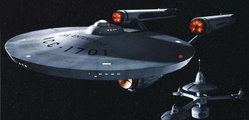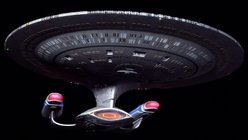Star Trek
Star Trek collectively refers to six science-fiction television series spanning 726 episodes, ten motion pictures, in addition to hundreds of novels, video games, and other works of fiction, all set within the same fictional universe created by Gene Roddenberry in the mid 1960s. more...
It depicts an optimistic, almost utopian future in which humanity has overcome sickness, racism, poverty, intolerance, and warfare on Earth, and has united with other intelligent species in the galaxy; the central characters explore the galaxy, discovering new worlds and encountering new civilizations, while helping to promote peace and understanding.
"Star Trek" (or sometimes merely "Trek") is one of the most popular names in the history of science fiction entertainment, and one of the most popular franchises in television history.
Television series
Star Trek originated as a television series in 1966. There have been five live-action Star Trek series and an animated series, altogether comprising (as of May 2005) a total of 726 individual aired episodes (not including the original unaired pilot) and thirty seasons’ worth of television.
Star Trek (1966-1969)
Star Trek debuted on NBC on September 8, 1966, having aired in Canada some days earlier. Created by Gene Roddenberry, starring William Shatner, Leonard Nimoy, and DeForest Kelley, and co-starring James Doohan, George Takei, Nichelle Nichols, and (later) Walter Koenig, it told the tale of the crew of the starship Enterprise of the United Federation of Planets and Starfleet and their adventures "to boldly go where no man has gone before."
The first episode aired, "The Man Trap," was actually the fifth produced. Originally, Roddenberry had created a pilot entitled "The Cage," with a very different cast, led by veteran actor Jeffrey Hunter, which was rejected by the three major television networks of the time. However, the NBC network liked the pilot enough to commission an unprecedented second pilot, "Where No Man Has Gone Before," which featured an almost entirely new cast led by Shatner. Only the character of Spock remained, at Roddenberry's insistence. "Where No Man Has Gone Before" was the third episode aired, while "The Cage" was reworked into a two-part episode, "The Menagerie."
The last original episode, "The Turnabout Intruder," aired on June 3, 1969. The series subsequently became phenomenally popular in syndication, ultimately spawning the film and television sequels that followed. It has in recent years become known as Star Trek: The Original Series, abbreviated as ST:TOS or TOS, to distinguish it from its sequels. All subsequent films and television series, except the animated cartoon series of the 1970s, have subtitles included as part of their official names.
Star Trek (Animated) (1973-1974)
The series was aired under the name Star Trek, but it has become widely known as Star Trek: The Animated Series (or abbreviated as ST:TAS or TAS). It was produced by Filmation and ran for two seasons, with a total of twenty-two half-hour episodes. It featured most of the original cast performing the voices for their characters. While the freedom of animation afforded large alien landscapes and exotic lifeforms, budget constraints were a major concern and animation quality was poor.
A few episodes are especially notable due to contributions from well known science-fiction authors. However, the series is not considered to be canon, which has caused controversy among some fans. The episode "Yesteryear" is considered by some sources such as the Star Trek Encyclopedia to be a partial exception concerning the events depicted in Spock’s youth (although it still officially remains non-canon along with the rest of TAS). Even so, elements of the animated series have worked their way into official canon, such as Kirk’s middle name, Tiberius, first revealed in TAS and made official in Star Trek VI: The Undiscovered Country. Star Trek: Enterprise also incorporated several TAS concepts into canon. So, while the series itself is not strictly canon, it has been used as "canon fodder."
Star Trek: Phase II (1978; unproduced)
Star Trek: Phase II was set to air in 1978 as the flagship series of a proposed Paramount television network, and 12 episode scripts were written before production was due to begin. This series would have put most of the original crew back aboard the Enterprise for a second five-year mission, save for Spock, because Leonard Nimoy did not agree to return; a full-blooded Vulcan named Xon was planned as a replacement, although it was still hoped that Nimoy would make guest appearances. Sets were constructed and several minutes of test footage were filmed. However, partly because of the popularity of the recently released film Star Wars Episode IV: A New Hope, Paramount decided to make a Star Trek film instead of a weekly television series. The first script formed the basis of Star Trek: The Motion Picture, while two others were eventually adapted as episodes of Star Trek: The Next Generation.
Star Trek: The Next Generation (1987-1994)
Star Trek: The Next Generation (also known, colloquially, as The Next Generation, NextGen, ST:TNG, or TNG) is set nearly a century later and features a new starship (also named Enterprise) and a new crew, venturing where "no one has gone before."
It premiered on September 28, 1987, with the two-hour pilot episode, "Encounter at Farpoint," and ran for seven seasons, ending with the final two-part episode, "All Good Things..." on May 29, 1994. The show gained a considerable following during its initial run. Even during that time, the show was produced solely for syndication.
Star Trek: The Next Generation had the highest ratings of all the Star Trek series and was the number-one syndicated show during the last few years of its original run. Many fans, both casual and "hard-core," often treat The Next Generation as a kind of 'golden age' of Star Trek, primarily because of its broad acceptance, its viewer base, and the active influence of Roddenberry (who was alive during the first part of its run).
Read more at Wikipedia.org



